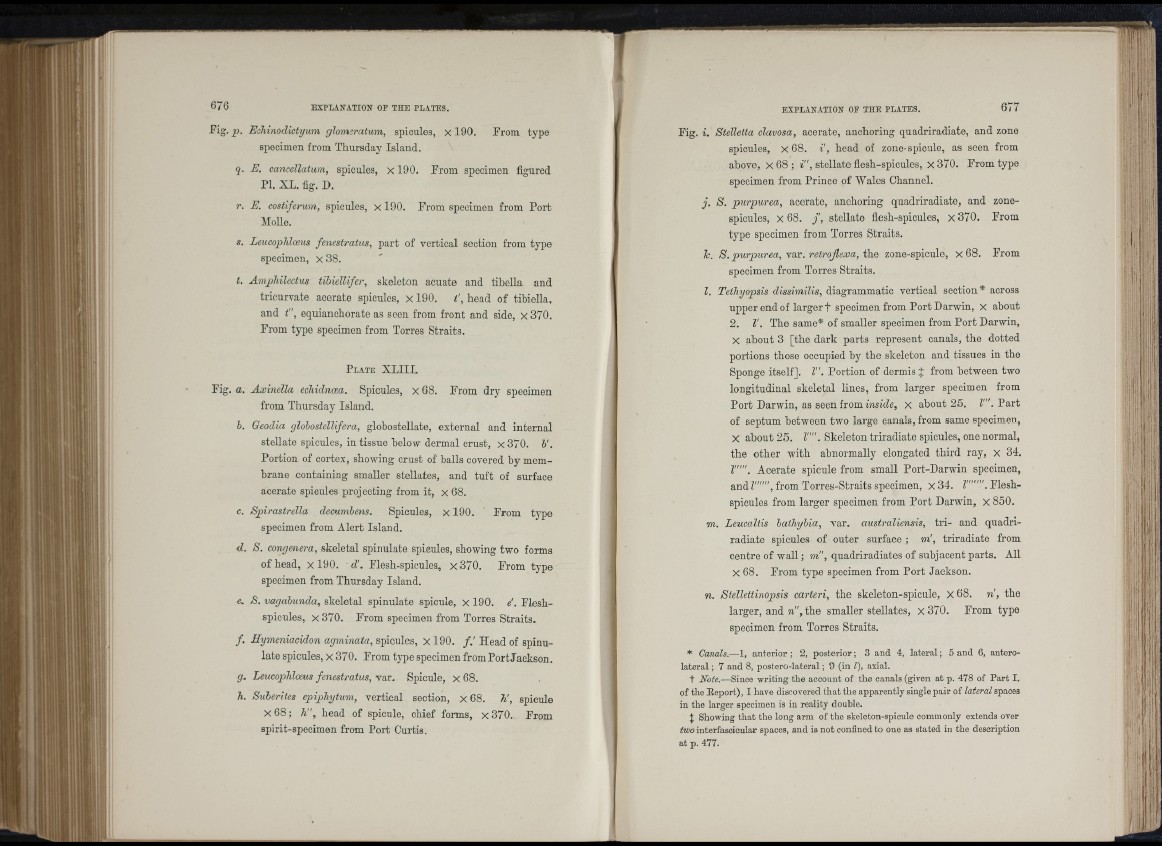
Î!D + !
iiili j
I
. riP '
i i i ttrr
ill", Û'
Hi
Ü!
Fig. p . Ecliinodictyum glom;ratum, spicules, x 190. From type
specimen from Thursday Island.
5 . E. cancellatum, spicules, x 190. From specimen figured
PI. XL. fig. D.
r. E. costiferum, spicules, x 190. From specimen from Port
MoUe.
s. Leucophloeus fenestratus, part of vertical section from type
specimen, x 38.
t. Amphilectus tibiellifer, skeleton acuate and tibella and
tricurvate acerate spicules, x 190. t', head of tibiella,
and t", equianchorate as seen from front and side, x 370.
From type specimen from Torres Straits.
P l a t e X L III.
Fig. a. Axinella echidnæa. Spicules, x 68. From dry specimen
from Thursday Island.
h. Geodia globostellifera, globostellate, external and internal
stellate spicules, in tissue below dermal crust, x 370. V.
Portion of cortex, showing crust of balls covered by membrane
containing smaUer steUates, and tuft of surface
acerate spicules projecting from it, x 68.
c. Spirastrella decumbens. Spicules, X 190. From type
specimen from Alert Island.
d. S. congenera, skeletal spinulate spicules, showing two forms
of head, x 190. d'. Flesh-spicules, x 3 7 0 . From type
specimen from Thursday Island.
e. S. vagahunda, skeletal spinulate spicule, X 190. d . Fleshspicules,
x 3 7 0 . From specimen from Torres Straits.
/ . Hymeniacidon agminata, spicules, X 190. Head of spinulate
spicules, X 370. From type specimen fromPort Jackson.
g. Leucophloeus fenestratus, var. Spicule, x 68.
h. Suberites epiphytum, vertical section, x 68. h', spicule
x 6 8 ; h”, head of spicule, chief forms, x370._ From
spirit-specimen from Port Curtis.
Fig. i. Stelletta clavosa, acerate, anchoring quadriradiate, and zone
spicules, X 68. i', head of zone-spicule, as seen from
above, X 68 ; f", stellate flesh-spicules, X 370. From type
specimen from Prince of Wales Channel.
j . S. purpurea, acerate, anchoring quadriradiate, and zone-
spicules, X 68. / , stellate flesh-spicules, x 3 7 0 . From
type specimen from Torres Straits.
Tc. S . purpurea, var. retroflexa, the zone-spicule, X 68. From
specimen from Torres Straits.
I. Tethyopsis dissimilis, diagrammatic vertical section * across
upper end of larger t specimen from Port Darwin, X about
2. V. The same* of smaller specimen from Port Darwin,
X about 3 [the dark parts represent canals, the dotted
portions those occupied by the skeleton and tissues in the
Sponge itself]. I". Portion of dermis ] from between two
longitudinal skeletal lines, from larger specimen from
Port Darwin, as seen from inside, X about 25. I'". P a rt
of septum between two large canals, from same specimen,
X about 25. I"". Skeleton triradiate spicules, one normal,
the other with abnormally elongated third ray, x 34.
Z'"". Acerate spicule from small Port-Darwin specimen,
and Z''”'', from Torres-Straits specimen, x 3 4 . Z'"'”'. Flesh-
spicules from larger specimen from Port Darwin, x 850.
m. Leucaltis bathybia, var. australiensis, tri- and quadriradiate
spicules of outer surface ; m', triradiate from
centre of w a ll; m ', quadriradiates of subjacent parts. All
X 68. From type specimen from Port Jackson.
n. Stellettinopsis carteri, the skeleton-spicnle, X 68. n , the
larger, and n!', the smaller stellates, X 370. From type
specimen from Torres Straits.
* Canals.—1, anterior; 2, posterior; 3 and 4, lateral; 5 and 6, anterolateral
; 7 and 8, postero-lateral; 9 (in I), axial.
t Note.—Since writing the account of the canals (given at p. 478 of Part I.
of the Eeport), I have discovered that the apparently single pair of lateral spaces
in the larger specimen is in reality double.
[ Showing that the long arm of the skeleton-spicule commonly extends over
two interfascicular spaces, and is not confined to one as stated in the description
at p. 477.
I ti
f t
n '
\ I
j